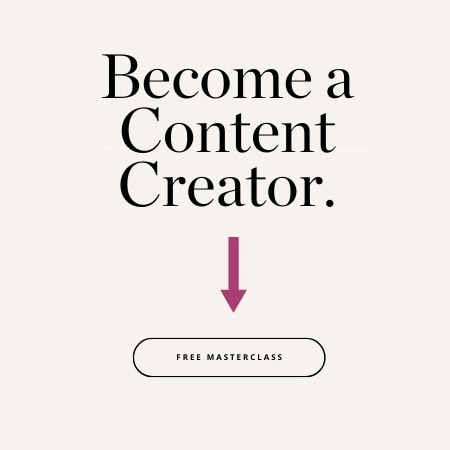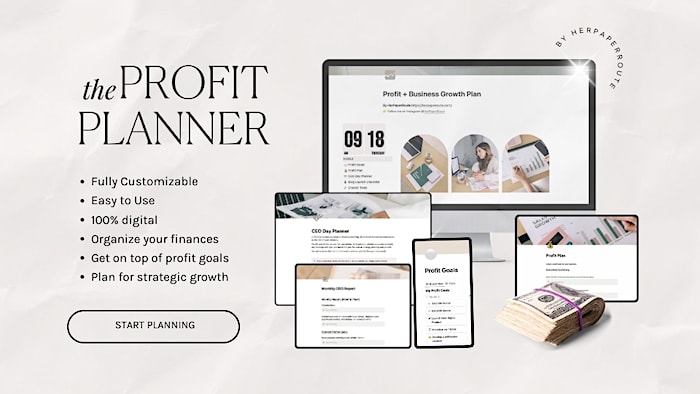13 Surprising Reasons Your Offers Aren’t Selling & The Fix

Your offers aren’t selling. Oh no! Do you struggle to sell your offers consistently?
For example, maybe some months your sales and revenue are okay… but then the next month, nada.
As an affiliate partner of various brands and sponsored content, HerPaperRoute may earn commission on qualifying purchases. Disclaimer
Or maybe you’ve created and launched a few different courses for your audience, but nobody’s biting.
In today’s post, I’m sharing 13 counterintuitive reasons your offers aren’t selling — and what you should do instead. All backed by psychology, the study of human behavior.

13 Surprising Reasons Your Offers Aren’t Selling
Have you ever had a course launch that flopped?
Or opened the cart only to have way fewer people buy than you had anticipated?
If you’re nodding along right now, I have a question for you…
What if you could use some basic sales psychology to make your courses 10x more enticing to your target audience?
And then, of course, make more sales as a result?
Good news: you can!
I’ve made it my mission to help as many creators as possible achieve financial freedom through their online businesses.
Over the past few years, I’ve helped thousands of creators set up, grow, and make money from their blogs.
Yet I often see my clients, readers and students make the exact same mistakes across the board.
Today, I want to share some stand-out reasons why your offers aren’t selling.
If you want to generate a serious profit from your blog, read this article carefully.
If you’ve ever thought, “Why isn’t this working? Why am I not making any money? I feel like I’m following all of the right steps!” — this post is for you.
Here are the major reasons why your offers aren’t selling and what you can do to fix it.
In addition to the tips below, be sure to read The Psychology Of What Makes People Buy From Your Sales Page, too!
1. your courses are *too* available
What do I mean by “too much availability”?
I mean that your courses are available for purchase all the time, year-round, with no incentive to join now.
This might seem like a good strategy. Because if people can buy your course anytime, wouldn’t you make more sales?
NOPE. Here’s why.
Robert Cialdini, the father of persuasion psychology, talks about the importance of a concept called “scarcity”.
He says that the more scarce a resource is (“scarce” meaning it’s only available in a limited quantity or for a limited amount of time), the more people actually value and desire that resource.
And this absolutely applies to your courses, too.
If there’s no element of scarcity surrounding your course, people won’t value it as highly or desire it as much.
Of course, that may or may not actually reflect on the value of your course—but it’s just the way the human brain works, so we need to cater to it with our sales strategy.
Here’s what to do instead:
Create scarcity and urgency around your courses. This will make them more desirable and enticing to your potential customers.
But the thing is, I also believe that courses should be evergreen, meaning they are open for enrollment year round.
So how does this mesh?
For example, you could:
1. Run a time-sensitive launch where your course BONUSES are only available with purchase within a 7-day window.
2. Or have limited bonuses available. Write on your sales page: “Only 2 [bonus name]s left!”, or however many bonuses are remaining.
Tip: If you have more than 5 left, simply write: “Limited [bonus name]s remaining!” instead of including a number.
Learn more about selling with bonuses here.
2. Your price point is *too low.*
Maybe you’re charging $29 for a 6-module online course, or $100 for a 12-week signature program (if so, girl, we need to talk!).
Really, any price point that’s drastically lower than the rest of your industry is what I’d consider to be “too low”.
And again, you might think this is a smart strategy that’s going to result in more sales. I mean, everyone loves a good deal, right!?
Sure, people love a deal.
But that doesn’t necessarily mean they’ll purchase the lowest-priced product on the market.
In fact, what can happen when your price is way too low is your audience automatically undervalues your course.
They think that your course must not be very good, or that you must not be that much of an expert in your field, because you’re charging such a ridiculously low price.
And then, of course, they’re much less likely to buy.
Here’s what to do instead:
Step into premium pricing.
Or at the very least, just don’t undercut the market.
For the most part, your prices should be similar to other people in your industry, or higher.
I always recommend setting your prices based on the value of your course and the transformation it helps facilitate for your students.
I don’t ever suggest pricing based on the “size” of your course or what’s included in it (more on this below).
I promise that when your course has a premium price tag, people will place a much higher value on it.
And the right people will be excited to buy from you.
3. You’re justifying the price of your course by sharing everything people *get* when they purchase.
So maybe you do have a premium price tag on your offer. Go you!
But at the same time, you’re making another crucial mistake that can kill your sales…
Only talking about what’s included in the course vs. what it will help people create and achieve in their business or life.
For example, you might find yourself saying something like:
- “This course is $2,000, BUT it includes all of the following:
- 10 modules
- 20 workbooks
- 5 Q&A calls”
- etc. etc.”
Once again, this might seem like the right way to talk about your courses to convince people to buy… but it’s not. Why?
Because if there’s one principle of sales psychology that’s stood the test of time, it’s that:
- people don’t care all that much about the nitty-gritty details of what’s included in a particular offer (what we call the “features”).
What they do care about, and what will be much more persuasive, is the results that your course will help them achieve and the transformation it will help them undergo (what we call the “benefits” of the offer).
Always remember: Benefits are what land the sale, not features.
Yes, it’s important to share the features of your course, but that should only be a small slice of your sales page and overall sales strategy. The vast majority should center around the benefits.
Here’s what to do instead:
When talking about your course with potential customers, focus on sharing these 5 things:
- Who the course is for
- The pain points and problems those people are facing
- How your course is a solution to those problems
- The results it will help people achieve
- The transformation it will help them undergo
If you can do that, your sales pitch will be 10x more persuasive, guaranteed.
4. Your niche and target audience aren’t specific enough.
In order to make a full-time income as a blogger, your niche and ideal audience need to be super-specific.
The more specific your niche and target reader is, the easier it is to create content and write copy that attracts those people to you.
- As an example, a niche I would say is not specific enough is: food blogging.
- A great example of a more specific niche is: vegan meals for busy families.
You see the difference, right? Always remember: specificity is what helps you stand out and sell out online. When in doubt, get more specific, not less.
4b. Your paid offerings aren’t specific enough.
You might have a really specific niche, but if your paid products or services aren’t specific enough, you’ll have a hard time generating sales.
Again, if you try to market yourself toward everyone under the sun, you’ll end up attracting no one.
A paid offering that isn’t specific enough would be: life coaching.
A better offering would be: life coaching that helps women in their 20s and 30s discover their purpose and find their perfect career path.
Can you honestly say you would hire someone whose sole offering was simply called “life coaching”?
You’d be much more likely to dig around until you found someone offering the exact, super-specific type of coaching you wanted, right?
This is why you need to be incredibly specific with the paid services and products you offer, as well as who you market them toward.
Here’s what to do instead:
Hone in on a specific niche and target audience, and then translate this specificity into your paid offerings.
Ask yourself:
- Who do I really want to serve and work with?
- What qualities would my ideal customer/client have?
- What offerings can I create that will serve and attract that type of person?
Then get to work!

5. You’re relying on strategies that require a lot of traffic to payout.
All monetization strategies are not created equal. Some will work better for particular audiences, niches, and bloggers, and some only work well for bloggers who have hundreds of thousands of page views every month.
Do you have hundreds of thousands of page views each month? If not, don’t sweat it!
There are plenty of ways you can earn money from your blog that don’t require that much traffic. I should know, because I don’t have nearly that many.
Strategies that don’t require tons of traffic are things like: selling online courses, writing ebooks, offering services, and – to an extent – affiliate marketing.
These strategies have been my bread and butter over the past couple years, and why I know for a fact that you can earn a full-time income online without having a large amount of traffic.
Here’s what to do instead:
Choose 2-3 strategies from the list above (online courses, ebooks, offering services, affiliate marketing) and learn everything you can about them.
Read blog posts, take courses, attend webinars. Immerse yourself. Learn everything you can about these strategies, and then put them into action for your blog and business.
6. Your paid offerings aren’t a fit for your audience.
Maybe you’ve already created an online course or ebook, but they just aren’t selling.
Most likely, it’s because those offerings aren’t a great fit for the people reading your blog or subscribing to your email list.
Your products, services, and courses might be a mismatch for your audience for lots of different reasons, like:
The skill level is off – for example, you’ve written a book for beginners but most of your readers are past the beginner stage
Your paid offerings don’t relieve a big pain point or solve a problem your readers have
Your audience isn’t willing to pay to have someone teach them about the topic of your book or course (because of their budget, the perceived value of the topic and problem addressed, etc.)
To create a successful product, course, or ebook, you need an intimate understanding of your audience members. Not just general things like their gender and age; you really need to know about their lives.
- How many kids do they have? How do they like their coffee?
- What are the biggest problems or pain points they have in relation to your niche?
- What would they be willing to pay in order to have that problem solved?
When you know your target readers like the back of your hand, you’re able to create paid offerings that speak to their needs and will sell easily.
Here’s what to do instead:
Get to know your readers. Really get to know them. Chat with them one-on-one, send out a survey, ask questions at the end of your blog posts and emails to solicit feedback. Write down everything you learn and use it to create better offerings!
7. You put all your eggs in one basket.
Focusing only one strategy for monetizing your blog, instead of dipping your hand into multiple pots, is one of the biggest mistakes of all.
I feel like I say this all the time, but did you know that the average millionaire has 7 or more different streams of income? That’s because the more streams of income you have, the more money you make.
Here’s what not to do: After hearing that so-and-so makes $20,000/month from her blog through affiliate marketing, you decide to spend all your time learning about affiliate marketing and trying it out, completely disregarding all other profit strategies.
This strategy of focusing on one method is only a good idea when you’re just getting started with monetizing your blog and as long as it’s only for a short period of time.
Once you’ve mastered that strategy, it’s time to move onto another one. At the end of the day, the more income streams you create, the more money will be entering your bank account.
Here’s what to do instead:
Choose 2 or 3 profit strategies that are a great fit for you, your blog’s niche, and your readers.
If you’re not sure what will be a good fit, go back to Mistake #3 above and do some more digging into your audience’s wants, needs, and preferences.
8. You’re letting perfectionism hold you back.
This is something I see 95% of bloggers struggle with on an almost-daily basis, but trust me when I say that you need to kick perfectionism to the curb a.s.a.p. if you want to create a profitable blog. Because the truth is that nothing you do will ever be perfect.
Waiting months and months to launch your blog, or to release a specific blog post, or to launch a paid offering because “it just isn’t perfect yet” is holding you back in more ways than you can imagine.
My motto will always be “progress over perfection”, and I encourage you to adapt this motto for your own blog and life as well. We’re all human, and there’s no shame in producing something that isn’t 100% perfect.
No one is going to judge you. In fact, most people will love you even more for just putting yourself out there, in all your imperfections, than they would if you waited 6 months to do something because you were too worried about it not being perfect.
Here’s what to do instead:
Whether it’s launching your blog, offering a paid service, creating a digital product — whatever — do it now.
Don’t wait. Money can’t and won’t come to you unless you put yourself out there and start creating things that you can exchange for money. So get to work!
9. You don’t validate your ideas before creating and launching something.
If you don’t validate your product idea and make sure your audience actually wants the thing you’re creating, it’s like aiming at a dartboard with a blindfold on.
Once in a blue moon, you might hit a bullseye, but a lot of the time, your dart won’t even land on the board.
All this is to say that validating your product/course/service idea is one of the most critical steps in blogging for profit.
Here’s what to do instead:
There are lots of different ways you can validate your idea with your audience, while also simultaneously generating hype around whatever it is you’re about to create.
Here are a few ideas:
- Create a quick survey with Typeform and send it to your mailing list
- Run a poll in your Facebook group (or another group where your readers hang out)
- Personally message 5-10 of your readers and ask if they’d be willing to answer a few questions for you
- To get more responses to a survey, it helps to offer something small to the people who answer your questions.
You might host a giveaway and choose one of the survey respondents to win a small gift card, or offer a 20% discount on your new service or product to the people you chat with one-on-one.
Once you’ve been given the green light from the majority of your audience, validating that your idea is something they’re willing to pay for, you can go ahead and create it.
10. Your price doesn’t match your target market.
If the people you’re hoping to sell to can’t afford the price tag on your offering, or if they simply aren’t willing to pay that much money for it, you have another misalignment that will lead to truncated sales.
It’s not necessarily fair that what you can charge hinges so largely on the amount of money other people have, but that’s just the way it is.
If your target market is moms who are on a tight budget and you decide to offer coaching for $500/hour, you’re going to have a hard time finding and booking clients.
At the same time, you need to be sure that the value you provide in your offering lives up to the price tag you’ve given it.
Sometimes it’s better to start your pricing off a little lower and gradually raise it over time as your skills, knowledge, and offerings improve.
Here’s what to do instead:
- Again, it comes back to having intimate knowledge of your audience and prospects.
- What do their bank accounts look like?
- Are they struggling to pay their bills?
- Which of their problems and pain points are so crippling that they’d be willing to pay money to have them solved?
Keep in mind that I’m not saying if your readers are only willing to pay $5/hour for coaching, that’s what you should charge.
Absolutely not. If you’re charging less per hour than what you could earn at your day job, you’re never going to be able to leave your job and blog full-time.
You need to find a balance between the value you provide and the amount of money you want to make, and what your clients and customers are happy to pay.
11. You haven’t built up trust, connection, and expert status.
These three qualities are what I call “The Sales Trifecta”. You might have heard this referred to as the “like, know, trust” factor.
Essentially, before someone is willing to buy something from you, they need to like, know and trust you.
This is why your main job as a blogger and entrepreneur is to build up your expert status, trust, and connection with your audience.
My favorite way to do this is through my email list. Email is the best way to communicate with your audience, keep them engaged, and show them how much you know about your area of expertise.
Here’s what to do instead:
If you don’t have an email list already, start one today! I suggest ConvertKit.
12. You don’t have an email list or aren’t using yours properly.
This is so important that I have to repeat it: your email list is crucial if you want to earn a full-time income from your blog.
You might make the occasional sale from your blog and social media posts, but the vast majority of your sales will come through your email list.
Why? Because you’ve used your email list to build up trust, personal connection, and expert status (the Sales Trifecta), priming your subscribers to buy from you.
Here’s what to do instead:
Every once in awhile, send out a pitch email to your list. Give them a discount on one of your offerings, add in a special bonus or two, and have a cut-off point of 24-72 hours.
Create simple email sales funnels to sell your digital products, courses, and books on autopilot. If you’ve used your email list to build up The Sales Trifecta, you will make sales when you do this.
13. You’re undercharging.
It’s so important to value yourself and the work you do.
Whether it’s a signature service you offer, a course you’ve created, or an ebook you’ve written, undervaluing yourself and your time will get you nowhere.
In fact, it’s a one-way ticket to burnout and an empty bank account. And we don’t want that!
What you offer is special, unique, and valuable.
Don’t let anyone tell you differently. You were put on this earth for a purpose, and you’re doing your best to live out that purpose.
A common mindset hurdle (especially for women) is feeling like we should be using our special gifts and talents to “do good in the world but at the same time, that it’s not okay to accept money for our natural gifts.
For example, if you’re an artist, you might find so much joy in painting or pottery or drawing or whatever it is that you love to do, that you feel guilty asking people to pay you for your art.
Here’s what to do instead:
Remember that what you have to offer is highly valuable and that it’s absolutely worth paying money for.
Don’t feel like you’re “taking” money from someone and leaving them with a shortage when they make a purchase from you.
You’re simply exchanging energy (time and skills for money) in a way that’s beneficial for both parties involved.
14. You have a scarcity mindset.
According to the Law of Attraction, the more positive your emotions, mindset, and outlook on life are, the more joyful and positive things you attract into your life.
This applies to money, too. If you constantly have a negative mindset toward money, feeling like there’s never enough to go around and thinking how much you hate being broke, you’ll only attract more broke-ness into your life.
Here’s what to do instead:
You need to constantly focus on the positives and aim to see the silver lining in everything. Trust that there will always be enough money to go around.
Trust that you’ll always be provided with everything you need. Focus on all the good, joyful things in your life, and let any negative thoughts fade away.
Instead of thinking about how you never make money from your blog and how you wish you weren’t so broke, think thoughts of wealth and abundance and be grateful for every single cent that flows your way.
So tell me: which of these mistakes have you been making?
If it’s more than a few, that’s okay!
You now have everything you need to turn your situation around and start making some serious cash by improving how you sell your offers.
13 Surprising Reasons Your Offers Aren’t Selling & The Fix – Conclusion
Are you guilty of doing any of these 13 reasons that cause offers to not sell?
If so, don’t sweat it (it’s not like they teach this kind of stuff in school!).
But I do teach this stuff at HerPaperRoute. Come join a program today.
But now that you’ve read this post, you have three new methods for promoting the offers that will help you land the sale much more easily.
All backed by good ole sales psychology.
Was this helpful for you? Do you have any questions? Let me know below!
Keep Reading:
- How To Make Affiliate Marketing Money Without a Website
- 12 Clever Ways To Promote Your Blog
- The Psychology Of What Makes People Buy

Follow along on Instagram!












